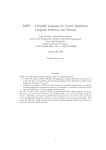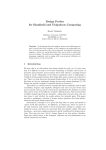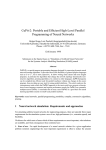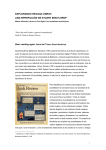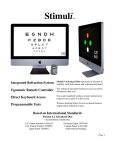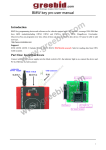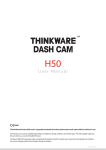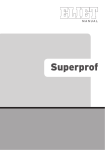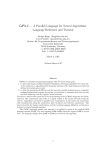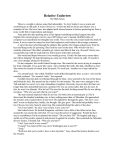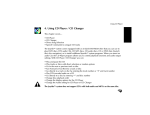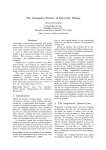Download Ethics and consumer electronics
Transcript
Ethics and consumer electronics Harold Thimbleby & Penny Duquenoy Gary Marsden Middlesex University School of Computing Science LONDON, N11 2NQ United Kingdom http://www.cs.mdx.ac.uk University of Cape Town Department of Computer Science Private Bag RONDEBOSCH, 7701 South Africa. http://www.cs.uct.ac.za/ Abstract The design of car (automobile) radios exposes ethical issues in the design of consumer electronics. We show that car radios, despite being manufactured for many years and being a well-understood technology, are unsafe to use. It is implausible that manufacturers design such unsafe devices unwittingly. We argue that complex in-car devices raise clear ethical issues: (i) their complexity of operation demands and diverts driver attention from road safety (social ethics — social responsibility) (ii) the values embedded in their design (e.g., marketing values, seductive styling) are not consistent with their function (design ethics — issues of professional responsibility) Further, we show there is a correspondence between theories of justice and these ethical issues. Introduction This paper proposes that the evident unnecessary complexity (of technological systems) is an ethical issue, and we illustrate our argument with examples from in-car devices. In-car devices provide a clear trade-off: their design complexity requires attention and attention on the roads is of paramount importance for safety — and is legislatively recognised as such. Our position can be set out: Facts: — preservation of human life “on the road” requires driver attention — attention (as a human cognitive resource) is limited — complex interactive devices require attention — road safety requires driver attention Evidence of this paper: — in-car devices are complex and divert driver attention — the complexity is unnecessary for the manifest purpose of the devices Argument: — preservation of human life (in these circumstances) is an ethical priority — human life is unnecessarily at risk — hence, the design of consumer electronics for cars is unethical This reasoning is, we think obvious. Ignorance of issues is not an excuse: indeed, under law, it is not a valid excuse; and (we would argue) that in-car devices and their safety issues have been obvious to reasonable people for many years. Newspapers report accidents, and car safety has a high profile in most Western countries. With such an argument, it is important to use an explicit framework. We take the UK Road Traffic Act, as interpreted in the Highway Code. This is a public document, with legislative status for driving. For example, to pass the UK driving test substantial theoretical Figure 1: AutoPC: a car radio-sized PC (reproduced from Clarion’s web site, http://autopc.com/, 1999). and practical knowledge of the Highway Code is tested. Ignorance of the Highway Code can be used as evidence in court proceedings to establish liabilities. As it puts it, “Knowing and applying the rules contained in the Highway Code could significantly reduce road accident casualties. Cutting the number of deaths and injuries that occur on our roads every day is a responsibility we all share.” The Highway Code summarises the rules, thus expressing a rule-based ethical framework for people who wish to be part of the community of road users. This paper argues that, somehow but quite clearly, the design of electronic in-car devices (such as car radios) has circumvented the explicit ethical assumptions of the Highway Code, and indeed of “common sense” driving safety. Overview of the context The British Highway Code, the definitive guide to safe and legal driving in Britain, has recently been updated and now interprets the Road Traffic Act (1988, sections 2 & 3) more strictly: “You MUST exercise proper control of your vehicle at all times. Never use a hand held mobile phone or microphone while driving. Using hands free equipment is also likely to distract your attention from the road. It is far safer not to use any telephone while you are driving — find a safe place to stop first.” Highway Code, Section 127. “There is a danger of driver distraction being caused by in-vehicle systems such as route guidance and navigation systems, congestion warning systems, PCs, multimedia, etc. Do not operate, adjust or view any such system if it will distract your attention while you are driving; you MUST exercise proper control of your vehicle at all times.” Highway Code, Section 128. And, “Safe driving needs concentration. Avoid distractions when driving such as … loud music, trying to read maps, tuning a radio.” Highway Code, Section 126. Legally these recommendations can be “relied upon by any party to … establish … any liability which is in question …” Road Traffic Act, 1998. These legislative driving codes arise from a recognition that in-car systems are potentially dangerous because of their complexity. At the same time, manufacturers are increasing the complexity of in-car systems. Clarion, a leading manufacturer, has announced a “car PC,” a radio-sized PC, which provides Microsoft Windows access to the Internet for email and other services as well as to navigation, and normal radio and hi-fi functions; see Figure 1. In 1998 the best-selling car radio in Tottenham Court Road, London was a Kenwood, and had a user manual of over 500 pages. This represents quite substantial complexity; a driver cannot look at a manual while driving, so (even if some of the user manual is irrelevant to driving conditions) there is still a considerable learning burden. Thus, on the one hand there is recognition of driving problems, and on the other hand the manufacture of products that (as we shall argue) compromise safety. A range of pressing ethical issues are raised. Further, the ethical issues that are represented in a clear-cut way in this domain are indicative of more subtle trends in other domains. Our lives are becoming increasingly dominated by gadgets, and thinking clearly about the issues raised is easier in a domain such as transport, which has a regulatory framework that makes distinctions between “appropriate” and “inappropriate” behaviour manifest. (The Sale of Goods Act 1979 (as amended by the Sale and Supply of Goods Act 1994 and the Sale of Goods (Amendment) Act 1994), which require that products should be fit for purpose and should correspond with the description of them, impose weaker requirements than the Road Traffic Act.) Justice and design There are three aspects we explore as they relate to the ethical conception of justice. (i) In-car entertainment is promoted by marketing, and responds to actual and perceived consumer demand. For example, car manufacturers perceive that they can sell their cars more easily if they contain sophisticated in-car systems. (ii) Given that the in-car devices have an appearance and functionality determined by the market, a second question is whether the devices are appropriately engineered. For example if using an in-car device requires understanding a long manual, then this seems implausible. (iii) The designer and user of a device do not have an equal relation mediated by the device. The designer is in control of the device and understands it deeply, but for the user, the device is fixed and largely unknown. These points relate closely to ethics, and to justice in particular: (i) Whether systems promote a higher quality experience of driving — over a wide range of possible dimensions, such as safety, alertness, relaxation, navigational knowledge — or not is a question of fittingness in Geoffrey Cupit’s sense of “justice as fittingness.” (ii) The second point relates to John Rawls’ notion of justice following from a “veil of ignorance.” (iii) Thus there is a lack of reciprocity between designer and user. Thus the third point relates to justice via the implicit social contract. Moreover, the design community has closely corresponding concepts: (i) “task fit” and (ii) “know the user” — but these have not hitherto been expressed ethically. In short, there is a precise correspondence between the design issues and clearly articulated notions of justice. We can go further, in two ways. First, we can put ethical approaches into correspondence with various competing design paradigms (utilitarian=e.g., the ISO definition of usability; deontological=guidelines; virtue=formal methods; and so on) and thus see that there is unlikely to be a resolution of the various methodological approaches (e.g., user centred — cf. Landauer, 1995; formal methods — cf. Harrison & Thimbleby, 1994) within the design community. Secondly, Rawls’ conception of justice is operational; that is, it can be recruited as a method for designing more ethically (Duquenoy & Thimbleby, 1999). Thus, a Rawlsian approach can be used to change the world, rather than merely describe what is wrong with it. Since in-car devices represent a high-margin and leading-edge technology, finding ways to make these devices “better” — itself an ethical judgement — is paramount; it is pleasing, then, that there could be spin-offs into many other areas of our lives with high technology. Problems with current examples The Appendix to this paper provides a list of reasonable tasks a driver would wish to undertake using a car radio, and it gives full details of the way in which a particular radio is used to achieve the driver’s goals. Here, in the body of the paper, we summarise the findings: — Routine tasks take a long time (some simple tasks take over ten minutes), and demand the driver’s almost full attention. — The radio is illegible and awkward to use. The radio has time outs, flashing indicators, which make it harder to use should the driver be distracted away from giving it full attention. These are standard egonomic issues (Murrell, 1965). — The user interface of the radio is intrinsically confusing, as well has having numerous features that are not mnemonic. — The radio has an attractive front panel, whose colours can be changed. We conclude the radio is designed to be sold, not used. This implies an ethical judgement, poor business ethics applied by the manufacturers. It is well to spell out our reasoning. Cupit (op. cit.) argues that notions of justice hinge on status, and acting justly is acting in accordance with status. To act unjustly is to treat people as either less than they are or as more than they are. Cupit writes, “Justice is a practical virtue, it is concerned with how we should act.” He locates the notion of justice in our moral thinking, by placing it in a system of ideas — the status system. To accept justice as fittingness (i.e., in the status system) is to view actions as primary. Treating fittingly: we treat by acting or failing to act. Reasons for action include: raising or lowering of beings or entities, and the treating of beings or entities as if they have a status other than that which in fact they have. “Thus there is a distinction between degrading actions which make, or tend to make, less (acts which make someone less than human, make someone unreliable, acts of desecration, and so on), and unfitting actions which treat as less (acts which treat someone as less than human, treat someone as unreliable, acts of irreverence, and so on).” In the case of in-car devices, then, the manufacturers know (in principle, they know precisely) what they are selling. A driver either has little choice (as when they buy a car with an installed system) or they do not have an informed choice (as when they buy after a visit to a shop, with inadequate time to test out the entire system, and no opportunity to test it in-car). So who is treating who unjustly? The marketing people, at least, are treating other road users, who are not consumers of their products, as less than they should be. Indeed, these other road users are not influenced by the status or other features of the radios: they are only influenced by the driver’s skill and attention available to use that to ensure they drive safely. We could argue that drivers treat other road users as less important than, say, the desire to change radio station. However to argue this would be to draw attention away from the manufacturer’s greater responsibility to the drivers — an argument that Ralph Nader (1965) has already defeated. The manufacturers are responsible for the car’s safe engineering. Radios in perspective, and versus other technological problems Are we worrying too much about one sort of problem, because it is easy to focus on, rather than being significant? For example, having argumentative children in a car may well place greater demands on the driver than even a badly-designed radio. A radio does not provide “emergency” demands like children can! For example, the New Scientist points out that we worry about mobile phones heating our brains, yet they don’t heat them as much as hair dryers do. Mobile phones are a “witch” — they are an obvious, complicated technology, that is easy to blame because we do not understand it, whereas hair dryers are well-established, and their heating our brains is easy to understand — in fact, it is practically what they are for, so there is no concealed surprise. On the other hand, unlike mobile phones, hairdryers don’t produce ionising radiation, so the arguments for and against are not so obvious as they might appear at first sight. In their article “Toward an Ethics of Persuasive Technology,” Berdichevsky and Neunschwander (1999) give a framework for clarifying the levels of ethical professional Figure 2: Rover75: view of display console (reproduced from Rover’s web site, http://www.rover75.co.uk/, 1999) responsibility based on predictable outcomes. Although their work is concerned with the domain of persuasive technologies, the principles are relevant to the issues being discussed here. Only when the outcome of the technology is unintended and “not reasonably predictable” can the professional be absolved from all responsibility. In the case of in-car devices, such as our example of the radio, the outcome of (non?)usability in the form of user distraction is easy to predict, and there are standard usability guides widely available. Manufacturers might respond in three ways. In the first instance they may say that complex design is not an issue; they might say they are responding to consumer demand — people like “buttons and features” so that is what they get; or they might decide that there are ethical issues that need addressing. Representatives of the consumer may take the view that counting features is not the only issue, and perhaps not their top priority. Worst of all they may see complexity as an inherent property of technology. Conclusions The operational difficulties encountered with our example of an in-car radio are unfortunately not specific to the model we studied. Similar difficulties are commonly experienced with many types of consumer electronics (e.g. fax machines; see e.g., Thimbleby 1997, video recorders). A different example from cars is illustrated by a Rover advert in The Times (page 6, June 1999): “Safety is Paramount” the advert starts, and it shows the interior of the Rover 75 (see Figure 2), which is “as safe as a tank” but has a video screen showing a map (presumably a GPS map) at such detail it would be hard to read. If a driver was seen trying to read a map while driving, the UK police would stop them, for “driving without due care and attention.” See the quotations, earlier in this paper, from Sections 126 to 128 of the Highway Code. We find it hard to see how a dynamic map display, in the centre console of the car — even if it was at a scale that was easily readable from the driver’s position — would not be a serious distraction from driving. Yet, somehow, the advert claims that the Rover 75 “passes the most stringent European safety tests.” The only way this can be interpreted as other than disingenuous is that perhaps the most stringent tests are mechanical safety (e.g., protection against impact) rather related to driver safety. Furthermore, user difficulties are not taken as a serious issue, either by designers/manufacturers, or even the users themselves. Can this issue be considered an ethical issue? We believe so. Users frequently diminish their own abilities and intelligence, accepting that they are “not clever enough” to understand the technology. Cupit (1996) posits that notions of justice are based on status, that is, to act unjustly is to treat people either “as less than they are” or “as more than they are.” His comments are not restricted to actions towards others, he includes actions to ourselves. Following this interpretation of justice, users are doing themselves an injustice by treating themselves as less than they are. Some people might say that it is up to the user to revalue themselves, either by training themselves to use the equipment, or perhaps making a deliberate choice that technology “is not their business” leaving understanding in the hands of the professional technologist. However, we maintain that it need not be so. Approaching the issues from the justice perspective shows discrepancies of equality between the designer/manufacture and the user. The fact that lengthy user manuals are considered a necessary accompaniment to these devices indicates an imbalance between the knowledge of the designer and the user. If user manuals are intended to redress this imbalance they mostly fail, and we would go as far as to say that they merely serve to make the user feel even more inadequate. We suggest that using the notion of a veil of ignorance, as described by John Rawls (1971) may focus the designer on user’s difficulties and yield beneficial results. We would like to take the idea of a social contract further, by stating that as a matter of justice users should be treated equally, and not “less than they are.” We take the position that designers/manufacturers are, at the very least, jointly responsible with the user — the balance of power is weighted on their side — they are the holders of knowledge and the means of change. Acknowledgements This work was supported by EPSRC grant number GR/M14548. Penny Duquenoy is a PhD student funded by EPSRC. References D. Berdichevski, and E. Neunschwander, 1999, “Toward an Ethics of Persuasive Technology”, Communications of the ACM, 42(5), pp. D. Concar, D. Graham-Rowe, P. Marks, “Special Investigation: Mobile Phones,” New Scientist, pp20–25, 162(2181), 1999. Editorial, p3. G. Cupit, 1996, Justice as Fittingness, Oxford University Press. Driving Standards Agency, The Highway Code, The Stationery Office, 1999. P. Duquenoy & H. Thimbleby, “Justice and Design,” IFIP Conference on Human Computer Interaction, Interact’99, 1999 (in press). M. D. Harrison & H. W. Thimbleby, editors, Formal Methods in Human Computer Interaction, Cambridge University Press, 1994. T. Landauer, The Trouble with Computers, MIT Press, 1995. K. F. H. Murrell, Ergonomics: Man in his working environment, Chapman and Hall, 1965. R. Nader. Unsafe at Any Speed, Pocket Books, 1965. Pioneer, KEH-P7600R User Guide, J. Rawls, A Theory of Justice, Oxford University Press, 1972. (Originally published 1971, Harvard University Press.) H. W. Thimbleby, “Design for a FAX,” Personal Technologies, 1(2), pp101–117, 1997. Appendix We now give specific examples of design problems with car radios. For the sake of concreteness — and so that readers of this paper can check our comments — all discussion relates specifically to the Pioneer KEH-P7600R radio and the Peugeot 505 car. Experiments with the car radio were performed with the radio outside of the car, in a rig, and in “ideal” laboratory conditions, that is, not under driving conditions. All measurements were taken with the car stationary. For each task, we draw a conclusion about the consequences of the design of the radio, and we very briefly offer an alternative design approach that could avoid the problem. Although our purpose is not to explore design alternatives in this paper, the intention is to show that the design problems are not inevitable and that trade-offs — of course, not necessarily those we suggest — could have been made that would have resulted in a safer design. 1. A reasonable task is “I want to listen to another radio station.” We conclude that the radio provides confusing sound feedback to the driver. Find the > button and press it for between 0.2 to 3 seconds. (Pressing it less that 0.2 seconds causes the frequency to step; pressing it for more than 3 seconds causes it to increase continuously while the button is held down.) Unfortunately, the radio beeps at 0.2 seconds, on releasing the button, and at 3 seconds. Thus a brief press of 0.5 seconds gets two beeps — which we’ve found confusing because if you wait for two beeps, the radio does not seek another station, but changes the frequency continuously while the button is held down. Possible alternative design: The confusion is caused by a single sound having more than one meaning. The problem could be solved by using different pitches of beep. 2. A reasonable task is “I want to listen to a music programme.” We conclude that simple tasks with the radio are distracting for long periods of time. RDS is an scheme to make radio stations more informative; it allows a radio transmission to send data that the radio itself can make use of. For example, RDS can be used to find radio programmes that are transmitting music. Imagine a driver is listening to some music, but wishes to listen to some other music. The driver may use RDS to find some, as follows. Press the PT button (why is it called PT?). The radio then seeks for an RDS channel — that is, a radio programme that has the additional RDS information the radio understands (not all programmes have RDS information). The RDS category the driver is searching for flashes on the front panel of the radio (so may be very difficult to read unless the driver glances for several seconds at the radio — if the driver glances down, the category may be flashed off, and the display will look as though there is nothing there). The driver needs to check, because the current RDS category may be NEWS, say, not music. A category search for a suitable radio station takes up to 15 seconds. To change the RDS category, the driver must press PT for 2 seconds, then press >, then press ^. This changes the category; then the driver must press PT, as before, to search for the newly selected category. This sequence of actions takes a driver 10 seconds of full concentration on the radio. There are two choices open to the driver: 1. the driver looks down to check which category is chosen (some are SOCIAL, RELIGION, and we are assuming the driver wants music), and keeps on changing category until a music category is selected, or 2. the driver selects each category, and scans it until the radio finds some music. This does not require the driver to look at the radio, but it takes longer since the radio will spend 15 seconds on each search — 15 seconds for SOCIAL, 15 seconds for RELIGION, etc. How long does each choice take? 1. The driver chooses music categories. This takes 15 seconds of full attention, plus the radio’s 15 second search. If the search is unsuccessful (e.g., because there is no JAZZ) then the driver must repeat the process. This may require up to 11 attempts, as there are that many different music categories. Total driver time is 165 seconds — assuming no errors and full attention to the radio. Total radio time is 165 seconds. Overall time is 330 seconds, about 5 minutes. 2. The driver chooses the next RDS category, does a search and waits to hear the selected station. This requires less continual attention from the driver, but there are more RDS choices to work through. There are 30 categories, and in the worst case the one the driver wants will be the last one looked at. Note that although there are several music categories, there is no general music category; even OTH MUS means music not otherwise categorised (so, for example, it will not find jazz). Total driver time is 30×10=300 seconds. Total radio time is 30×15=450 seconds. Total time is 750 seconds, over 12 minutes. These times are surprisingly long. If the driver makes mistakes using the radio, the times will increase, as will the amount of attention the driver needs to devote to the radio. This is ironic: if the driver is distracted from the radio by a driving task, they are then going to have to spend more time on the radio, thus further diverting their attention from driving. Possible alternative design: A large part of the delay is caused by the radio having only one tuner. If the driver has to listen to a channel, the radio cannot be searching for another channel. Two tuners would remove 15 second delays from the interaction. Having no timeouts would make it easier for the driver to pay attention to driving tasks without risk of losing their “place” in the interaction. 3. A reasonable task is “I want to read the radio’s display.” We conclude the radio’s display is not intended to be read by the driver. The modes the radio is in can be seen from the radio’s display. Some of the indicators are text about 1.5mm high and which can only be viewed if the eyes are greater than 45 degrees below the panel plane. Some of these indicators are merely information (say, whether the sub woofer is on or off); others are relevant to what the user may want to do (say, whether the radio broadcast may or may not be interrupted with traffic announcements: the TA (2mm) symbol). In a Peugeot 505, the radio-to-eye angle is 70 degrees (the ideal might would be 90 degrees; since the radio is tilted 15 degrees away from vertical, towards the driver, the angle of view is less than the angle to the dashboard), and my eyes are 80cm from the panel in a normal driving position. The highway code requires that a driver can, at a minimum, read a vehicle number plate at a distance of 20.5 metres in good daylight. Lighting (as in driving at night) affects visual acuity, but let us generously ignore that, as well as the change in distance (which requires the eye to accommodate — presumably a driver can read their instruments, and the requirements on visual accommodation is not a special problem of radios). The writing on a legal UK licence number is 8cm high [well, mine is; I don’t know what the law is]. Doing the sums: 8cm at 20.5 metres is equivalent (so far as the image on the eye’s retina is concerned) to 3.1mm at 80cm (3.3mm at 70 degrees). Yet some of the radio’s text is 1.5mm high, so at the 70 degrees viewing angle its effective height is 1.4mm. This is known to be too small to read for drivers who are able to pass the legal vision test. Thus to read the radio’s status lights, the driver has to move their head closer and (in this car) lower. Doing the sums, the driver would have to move their head 0.64 metre closer to the radio. Doing so will significantly reduce their vision of the road — not that they can be looking at the radio and the road at the same time. Possible alternative design: Important symbols on the radio display could be made a readable size. The radio display has effectively spare space, currently taken up with icons. Alternatively, some of the fixed symbols need only appear when they are relevant. A different approach would be to make better use of sound — see the comment on beeps above — as the radio is obviously used by a driver who is able to listen to its output! 4. A reasonable task is “I want to do some driving.” We conclude that the radio is not designed for driving conditions. The radio has various time outs, so if any distraction takes more than a second or so (times seem to vary in different parts of the radio’s interface), or requires both hands of the driver, the radio will not be in the intended mode (after the radio times out), and the driver will have to start over (and almost certainly look at the radio again). Alternatively, the driver may rush their other task, so that they can resume using the radio before it times out, and loses what they were doing. (We noted above (A2) that the radio’s display has some flashing indicators. These cannot be seen by a short glance at the radio — they may be flashed off at that moment.) Possible alternative design: Remove the timeouts. Timeouts are a heavy-handed way of providing UNDO and CLEAR functions. Other design-related comments The Appendix gives a range of driver tasks and explains the problems they cause for driver attention. Lest the impression is created that that is an exhaustive summary of the design problems, here are a few more, in outline: — The radio has a remote control, with a different user interface — The radio has a programmable key with different meanings — The radio has some buttons do nothing for 2 seconds (have to be held continuously before they work) — The radio has numerous features such as FIE whose meaning is not obvious — The radio has a user manual 76 pages long (e.g., not easy to read when driving) — The spacing of the radio’s front panel buttons is about 0.8cm, less than any other incar controls









